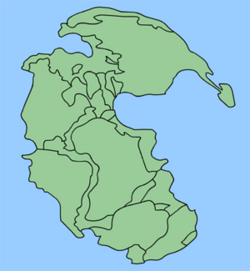Difference between revisions of "Paleozoic" - New World Encyclopedia
m ({{Paid}}) |
Rick Swarts (talk | contribs) |
||
| Line 12: | Line 12: | ||
==Tectonics== | ==Tectonics== | ||
| − | [[Image:Pangaea.png|right|250px|thumb|Map of Pangaea]] | + | [[Image:Pangaea.png|right|250px|thumb|Map of Pangaea, which began to form near the end of the Paleozoic]] |
Geologically, the Paleozoic is considered by some scientists to begin shortly after the breakup of a hypothesized supercontinent and at the end of a global [[ice age]]. Throughout the early Palaeozoic, the Earth's landmass was broken up into a substantial number of relatively small continents. | Geologically, the Paleozoic is considered by some scientists to begin shortly after the breakup of a hypothesized supercontinent and at the end of a global [[ice age]]. Throughout the early Palaeozoic, the Earth's landmass was broken up into a substantial number of relatively small continents. | ||
Revision as of 03:18, 8 December 2006
The Paleozoic (from the Greek palaio, "old" and zoion, "animals", meaning "ancient life") is a major division of the geologic timescale and the earliest of three geologic eras of the Phanerozoic eon. It is followed by the Mesozoic and Cenozoic eras.
The Paleozoic spanned from roughly 542 million years ago (mya) to roughly 251 mya (ICS 2004). It is subdivided into six geologic periods. From oldest to youngest, these six periods are the Cambrian, Ordovician, Silurian, Devonian, Carboniferous, and Permian.
The start of the Paleozoic, between roughly 542 mya and 530 mya, is a time that presents a major enigma for Darwinian evolution. This is is the phenomenon known as the Cambrian explosion, when there was a geologically sudden appearance of a large number of body plans. Indeed, all of the major body plans (phyla) of complex, multi-cellular macroscopic organisms that exist today appeared in this time period, and since then no fundamentally new body plan has come into existence. (See Cambrian explosion.)
The division of time into eras dates back to Giovanni Arduino in the 18th century, although his original name for the era now called the Paleozoic was "Primitive."
| Phanerozoic eon (542 mya - present) | ||
|---|---|---|
| Paleozoic era | Mesozoic era | Cenozoic era |
| Paleozoic era (542 - 251 mya) | |||||
|---|---|---|---|---|---|
| Cambrian | Ordovician | Silurian | Devonian | Carboniferous | Permian |
Tectonics
Geologically, the Paleozoic is considered by some scientists to begin shortly after the breakup of a hypothesized supercontinent and at the end of a global ice age. Throughout the early Palaeozoic, the Earth's landmass was broken up into a substantial number of relatively small continents.
Toward the end of the Paleozoic era, the continents gathered together into a supercontinent called Pangea, which included most of the Earth's land area.
Paleozoic life
The Paleozoic covers the time from the first appearance of abundant, hard-shelled fossils to the time when the continents were beginning to be dominated by large, relatively sophisticated reptiles and relatively modern plants. The lower (oldest) boundary was classically set at the first appearance of creatures known as trilobites and archeocyathids. The upper (youngest) boundary is set at a major extinction event 300 million years later, known as the Permian extinction. Modern practice sets the older boundary at the first appearance of a distinctive trace fossil called Trichophycus pedum.
At the start of the era, life was confined to bacteria, algae, sponges and a variety of somewhat enigmatic forms known collectively as the Ediacaran fauna. A large number of body plans appeared nearly simultaneously at the start of the era—a phenomenon known as the Cambrian explosion, which occurred between roughly 542 and 530 million years ago. This period marks a sharp transition in the fossil record with the appearance of the earliest members of many phyla of complex multi-cellular macroscopic organisms). The sudden appearance of so many phyla, and the fact that since the Cambrian no new major body plans (phyla) have come into existence, represents a puzzling problem. While various explanations have been offered, some maintain that the Cambrian explosion presents a challenge to the supremacy of natural selection in directing evolutionary changes. (See Cambrian explosion.)
There is some evidence that simple life may already have invaded the land at the start of the Paleozoic, but substantial plants and animals did not take to the land until the Silurian and did not thrive until the Devonian.
Although primitive vertebrates are known near the start of the Paleozoic, animal forms were dominated by invertebrates until the mid-Paleozoic. Fish populations exploded in the Devonian. During the late Paleozoic, great forests of primitive plants thrived on land forming the great coal beds of Europe and eastern North America. By the end of the era, the first large, sophisticated reptiles and the first modern plants (conifers) had developed.
References and further reading
- Natural History Museaum. 1975. British Palaeozoic Fossils. The Natural History Museum, London.
- International Commission on Stratigraphy (ICS). 2004. [1]. (accessed September 19, 2005).
Credits
New World Encyclopedia writers and editors rewrote and completed the Wikipedia article in accordance with New World Encyclopedia standards. This article abides by terms of the Creative Commons CC-by-sa 3.0 License (CC-by-sa), which may be used and disseminated with proper attribution. Credit is due under the terms of this license that can reference both the New World Encyclopedia contributors and the selfless volunteer contributors of the Wikimedia Foundation. To cite this article click here for a list of acceptable citing formats.The history of earlier contributions by wikipedians is accessible to researchers here:
The history of this article since it was imported to New World Encyclopedia:
Note: Some restrictions may apply to use of individual images which are separately licensed.
